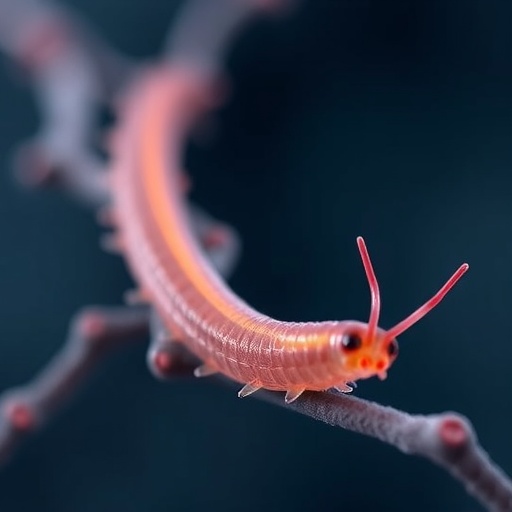In a groundbreaking study published in Cell Reports on October 15, 2025, scientists from the Stowers Institute for Medical Research have unveiled a remarkable mechanism underpinning the extraordinary regenerative power of planarians, a type of flatworm known for their ability to regrow entire body parts from tiny fragments. Contrary to the longstanding biological doctrine that stem cells rely heavily on their immediate niche—an anatomical microenvironment of neighboring cells providing precise signals to regulate their fate—this research reveals that planarian stem cells operate under a fundamentally different principle. They appear to bypass local proximity cues and instead respond to broader, systemic signals emanating from distant tissues, reshaping our understanding of stem cell regulation and offering tantalizing insights into future regenerative medicine applications for humans.
Traditional models in stem cell biology emphasize the ‘niche’ as an essential and relatively fixed microenvironment directly adjacent to stem cells, which delivers instructive signals that govern whether these cells divide, remain quiescent, or differentiate into specialized lineages. For example, in humans, hematopoietic stem cells reside in bone marrow niches, carefully guided to replenish blood cells without overproliferating, a balance crucial to prevent oncogenesis. However, the Stowers team, led by Postdoctoral Research Associate Dr. Frederick “Biff” Mann and Principal Investigator Dr. Alejandro Sánchez Alvarado, challenged this paradigm by demonstrating that planarian stem cells, or neoblasts, are largely uncoupled from such traditional niche constraints. Instead, these stem cells engage in a regulatory environment that is variable and influenced by distant signals, primarily from intestinal tissue, suggesting a ‘global’ rather than purely ‘local’ communication network.
This novel discovery emerged through the use of cutting-edge spatial transcriptomics, a technology that allows researchers to map active gene expression not just within single cells but across entire tissues, preserving spatial information. The application of this technique enabled the identification of a previously unknown cell type in the planarian stem cell microenvironment. These large, morphologically complex cells, dubbed “hecatonoblasts” after the mythological Hecatoncheires—creatures with many arms—exhibit extensive membrane projections. Surprisingly, despite their physical proximity to stem cells, hecatonoblasts do not control neoblast identity or function, contradicting conventional expectations for niche cells.
Further analyses showed that the strongest regulatory signals originated from the intestinal cells, distantly located yet crucial in dictating spatial cues and functional programming during regeneration. This finding aligns with a model wherein stem cells are informed of the organism’s overall physiological needs via systemic signals, rather than relying solely on immediate neighbors. Dr. Blair Benham-Pyle, co-corresponding author and Assistant Professor at Baylor College of Medicine, describes this as an integration of local and global networks, balancing immediate environmental interactions with organism-wide signals that guide expansive regenerative processes.
Planarian stem cells are renowned for their pluripotency—the ability to differentiate into any cell type within the organism—unlike stem cells in more complex animals, including humans, which generally display multipotency with lineage-restricted differentiation potentials. This robust plasticity raises the question of how neoblasts avoid oncogenic transformation despite their capacity for unlimited proliferation. The researchers propose that the absence of a fixed niche and the reliance on distant signals might be intrinsic factors facilitating controlled pluripotency, minimizing unregulated growth by distributing regulatory input across broader biological networks.
The implications of this discovery are profound for regenerative biology and medicine. Understanding the mechanisms that enable planarian stem cells to regenerate complex structures without a rigid niche framework could inspire novel therapeutic strategies to manipulate human stem cells more effectively. As Sánchez Alvarado emphasizes, elucidating the rules that govern stem cell specification and behavior in natural contexts may hold the key to preventing pathological conditions like cancer and enhancing regenerative therapies.
Moreover, this dynamic microenvironment wherein stem cells form transient ‘friendships’ with neighboring and distant cell types marks a departure from classical views of static niches. It suggests a model in which the stem cell milieu adapts continuously throughout the differentiation journey, reflecting developmental timing and organismal signals. Such plasticity may be essential to the planarian’s ability to restore lost tissues with impeccable accuracy and efficiency.
The discovery also highlights the importance of considering multicellular communication networks across various spatial scales—ranging from local cellular interactions to systemic signals influencing fate determination. This multiscale signaling complexity underscores the need to develop experimental and theoretical frameworks that transcend traditional niche-centric stem cell biology.
As advanced molecular tools like spatial transcriptomics continue to evolve, they promise to unravel further complexities of stem cell ecosystems in diverse species. The planarian, a model of regenerative prowess, stands at the forefront of this research, potentially bridging fundamental biological insights with translational applications in human health.
In summary, the Stowers Institute team’s findings represent a paradigm shift in the conceptualization of stem cell control. By revealing that planarian stem cells eschew the classical fixed niche for a more decentralized, system-wide regulatory environment, this work opens new avenues for understanding cellular plasticity, regeneration, and the molecular choreography inherent to tissue renewal. Such knowledge paves the way toward engineering enhanced regenerative medicine strategies capable of harnessing the body’s intrinsic healing capacity.
Subject of Research: Animals
Article Title: Molecular and cellular characterization of planarian stem cell microenvironments
News Publication Date: 15-Oct-2025
Web References:
https://www.stowers.org/labs/sanchez-alvarado-lab
https://www.bcm.edu/people-search/blair-benham-pyle-87171
https://www.stowers.org/
http://www.stowers.org/gradschool
References:
Mann, F.B., Benham-Pyle, B., Sánchez Alvarado, A., et al. (2025). Molecular and cellular characterization of planarian stem cell microenvironments. Cell Reports, October 15, 2025.
Image Credits: Stowers Institute for Medical Research
Keywords: Regeneration, Limb regeneration, Cartilage regeneration, Cardiac regeneration, Cell development, Developmental genetics, Developmental stages, Developmental timing, Evolutionary developmental biology, Life cycles, Evolutionary biology, Genetics, Molecular biology, Microbiology, Organismal biology, Downstream signaling, Cell fate regulation, Cellular noise, Signal transduction, Anatomy, Animal science, Animals, Biological systematics, Research methods, Evolutionary methods, Academic publishing, Scientific community, Research programs, Scientific method, Scientific publishing, Planarians, Invertebrates, Regenerative medicine, Medical technology, Tissue engineering, Bioengineering
Tags: biological mechanisms of regenerationbody part regrowth in wormsCell Reports study on stem cellsdistant tissue signaling in regenerationhealing mechanisms in planariansimplications for human stem cell therapyniche-free stem cell regulationplanarian flatworm regenerationregenerative medicine insightsstem cell biology breakthroughsStowers Institute research findingssystemic signals in stem cells





